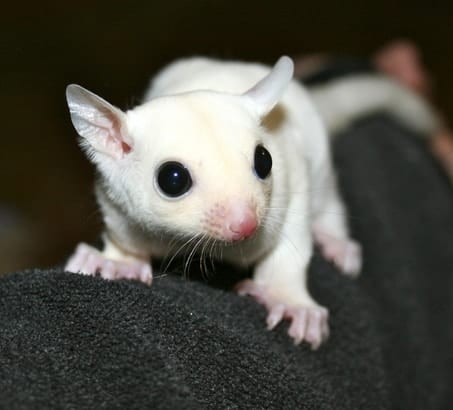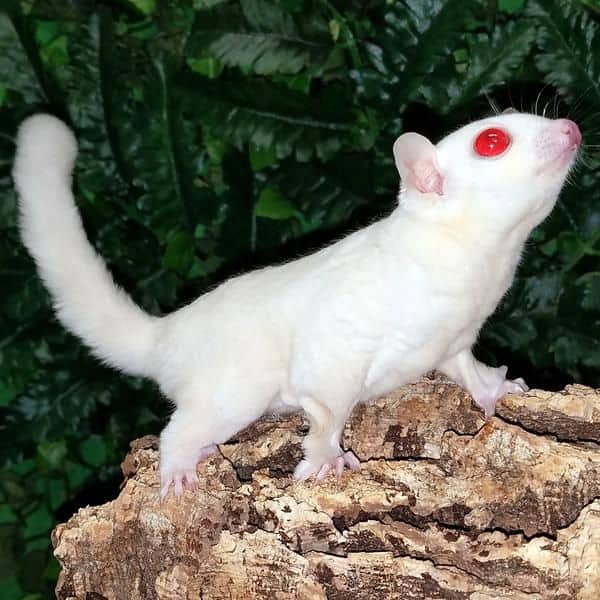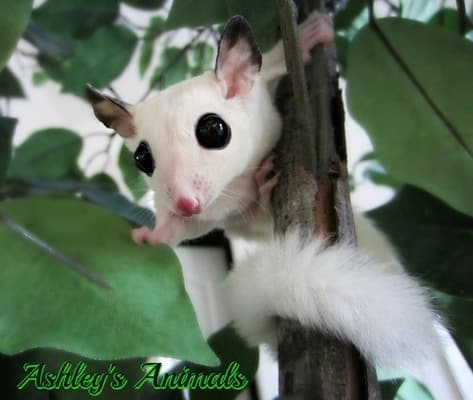The white sugar glider is extremely beautiful. Their completely white fur gives them a pristine, fresh look that’s very appealing to many people who keep them as pets.
The white sugar glider is among the most desired gliders out there because of its unique look. However, many people do not know all that much about them and there are quite a few misconceptions floating around.
In this post, we’re going to take a closer look at these pristinely colored creatures by going over the 9 most important facts about them.
9 Facts About White Sugar Gliders
1. White gliders are called leucistic

White sugar gliders are called Leucistic. They are gliders that have completely white fur with black eyes. In addition, they have translucent ears. Leucism is a term that describes the loss of pigmentation in the hair, but not in the eyes. As a result, their fur turns white!
However, it’s not always the case that their entire coat lacks color. It’s also possible that it partly turns white, this all depends on how many pigment cells fail to develop. Leucism is not exclusive to gliders, it can happen to gorillas, turtles, peacocks, and many other animals.
White sugar gliders carry a recessive gene and need two alleles of this gene for their white coat to be displayed physically. To demonstrate, to have a chance to breed white sugar gliders you have to breed two gliders that have this recessive gene.
2. They are not albino

Many people mistake them for albinos but they’re not the same. They both have white fur and can look quite similar, but there are differences between them.
For one, biologically they are not the same, however, that’s quite complicated to explain and not really the point of this post. If you’re interested in learning more about the biological differences between albinos and white gliders I suggest reading up on mutations and genes.
To give a brief explanation though: the leucistic sugar glider has a partial loss of pigmentation affecting the color of its hairs. Albinos on the other hand lack melanin which affects the pigmentation in their entire body, including their eyes.
The main way you can recognize the difference between leucistic and albino gliders is by looking at their eyes. Albinos have red eyes while Leucistic sugar gliders have dark eyes.
3. White mosaic gliders exist

In addition to albinos and leucistic gliders, there are also white mosaics. They’re a variation of the mosaic coloration. These gliders look very similar to leucistic gliders but are not the same.
They have almost completely white fur with almost no dark fur. They may have dark spots on their ears, differing in size and pigmentation which sets them apart from leucistic gliders.
4. White sugar gliders do not get dirtier than others
Since they have white coats, they do appear to be dirtier sometimes, but that’s just an illusion because dirt is much more visible on white surfaces.
Sugar gliders are very clean animals that groom themselves very frequently so this shouldn’t be a problem. A healthy glider does not need baths because they do an excellent job of keeping themselves clean.
Just make sure to keep their cage nice and clean and there should be no problem with them being any dirtier than other gliders.
5. Platinum gliders are not the same as white gliders
Platinum sugar gliders are often confused as being leucistic. They do look quite similar, but there are some differences that you should be aware of.
For starters, platinum sugar gliders are more of a silver-ish color rather than white.
Also, they have brownish markings on their body, whereas leucistic gliders are completely white.
6. They are quite rare
I couldn’t find any official statistics on the coloration distribution among sugar gliders. However, since white gliders are a result of a recessive gene and need two of them they’re definitely rarer than most other glider colorations.
In addition, it’s possible for leucistic gliders to be partial, rather than completely white, therefore, a completely white glider that’s not albino is quite a rare sight.
7. You can give them many cool names
If you’re considering getting a white sugar glider you might need some cool names for them. To give you some ideas, here are some names that are very suitable.
- Snowflake
- Lucy (from the word “leucism”)
- Pearl
- Casper
- Snowball
- Alaska
- Blizzard
- Lightning
- Icy
8. They’re not particularly expensive
I’ve done some research about the pricing of white sugar gliders. Taking into account the natural supply and demand I assumed that this coloration would be more expensive if they were very rare, but this was not the case.
Yes, they were slightly more expensive than the most common variations but not by a huge margin.
It’s also possible that this is the case because of the lower demand for them, who knows? One thing I will say though is that leucistic gliders had the lowest availability. Maybe the shops I was checking don’t price their gliders according to supply and demand…
If you want to buy them, most breeders have them for sale. You can buy them online at sites like this
To learn more about the white sugar glider price, check out this guide.
9. They have the same lifespan & behavior as other colors
There’s no difference in lifespan between the different color variations.
All sugar gliders have the same lifespan of 10-12 years.
In addition, their color does not affect their behavior.
- How Long Do American Eskimo Dogs Live? Important Factors and Care Tips - September 29, 2023
- Do American Bulldogs Need Grooming? Essential Tips and Care Guidelines - September 29, 2023
- Do Bengal Cats Enjoy Playing? Essential Tips for Keeping Them Active - September 29, 2023